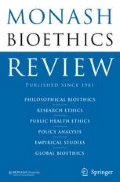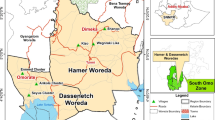Abstract
One Health, as an international movement and as a research methodology, aspires to cross boundaries between disciplines. However, One Health has also been viewed as “reductionist” due to its overemphasize on physicians-veterinarians cooperation and surveillance capacity enhancement, while limiting the involvement with socio-political preconditioning factors that shape the impact of diseases, and the ethical questions that eventually structure interventions. The current article draws on a qualitative study of Brucellosis control in Israel, to address the benefits of broadening the One Health perspective to include ethical considerations and the socio-political aspects of health. Using in-depth-interviews, observations and document review, the article analyzes stakeholders’ knowledge (policy makers, practitioners and livestock owners) to understand Brucellosis control interventions in the Negev region of Israel. The analysis highlights four different types of boundaries: geographical, professional, disciplinary and participatory. The variety of boundaries going beyond disciplinary ones, are often neglected by traditional One Health discourses, however they provide clearer understanding regarding the role of the Israel and Palestine relations; enforcement activities and trust creation; and mechanisms of decision-making and public participation, in Brucellosis interventions. A broad One Health analysis that addresses ethical concerns and socio-political environments, as well as human and veterinary medicine, encourages re-framing of causes and solutions when dealing particularly with Brucellosis in the Negev, but more generally with zoonotic diseases, low-trust settings and inequitable distribution of power. The inclusion of historical, political and bioethical considerations of Public Health in One Health creates opportunities to increase the relevance of One Health and expand its scope as a novel scientific paradigm.

Data taken from www.ecf.org.il (Economic Cooperation Foundation, 2017)
Similar content being viewed by others
References
Abu-Saad, I. 2006. Bedouin arabs in israel: Education, political control and social change. In The Education of nomadic peoples: Current issues, future prospects, ed. C. Dyer, 141–158. Oxford: Berghahan Publisher.
Algazi, G. (2010). From gir forest to umm hiran: Notes on colonial nature and its keepers. In Theory and criticism, by the Van Leer Jerusalem Institute, p. 232.
Almi, O. 2016. Houses in battlefront: Personal and social consequences of house demolition in the un-recognized villages of the Negev. In Trauma’s omen: Israeli studies in identity, memory and representation, eds. M. Alberstein, N. Davidovitch & R. Zalashik 383–384–439. Tel Aviv: Hakibbutz Hameuchad and Bar-Ilan University.
Alsana, F. 2015. Morbidity of brucellosis in the bedouin population in the negev. The Israeli Ministry of Health, Southern District.
Anis, E., A. Leventhal, I. Grotto, D. Gandacu, B. Warshavsky, A. Shimshony, et al. 2011. Recent trends in human brucellosis in israel. IMAJ-Israel Medical Association Journal 13 (6): 359.
Banai, M. 2010. Insights into the problem of B. melitensis and rationalizing a vaccination programme in Israel. Prilozi 31 (1): 167–180.
Bank of Israel. 2013. Trade links between Israel and the Palestinian authority. Israel: Bank of Israel.
Baxter, P., and S. Jack. 2008. Qualitative case study methodology: Study design and implementation for novice researchers. The Qualitative Report 13 (4): 544–559.
Bousfield, B., and R. Brown. 2011. One world one health. Veterinary Bulletin - Agriculture, Fisheries and Conservation Department Newsletter 1 (7): 1–12.
Braun-Lewensohn, O., S. Sagy, and H. Al Said. 2014. Stress reactions and coping strategies among bedouin arab adolescents exposed to demolition of houses. Stress and Health 30 (4): 333–342.
Corbel, M.J. 2006. Brucellosis in humans and animals. Geneva: World Health Organization.
Daoud, N., and Y. Jabareen. 2014. Depressive symptoms among arab bedouin women whose houses are under threat of demolition in southern israel: A right to housing issue. Health and Human Rights 16 (1): 179–191.
Davis, M.F., S.C. Rankin, J.M. Schurer, S. Cole, L. Conti, P. Rabinowitz, et al. 2017. Checklist for one health epidemiological reporting of evidence (COHERE). One Health. https://doi.org/10.1016/j.onehlt.2017.07.001.
Dean, A.S., L. Crump, H. Greter, E. Schelling, and J. Zinsstag. 2012. Global burden of human brucellosis: A systematic review of disease frequency. PLoS Neglected Tropical Diseases 6 (10): e1865.
Degeling, C., J. Johnson, I. Kerridge, A. Wilson, M. Ward, C. Stewart, et al. 2015. Implementing a one health approach to emerging infectious disease: Reflections on the socio-political, ethical and legal dimensions. BMC Public Health 15 (1): 1307.
Degen, A.A., R.W. Benjamin, and J.C. Hoorweg. 2000. Bedouin households and sheep production in the Negev desert, israel. Nomadic Peoples 4 (1): 125–147.
Degen, A.A., and S. El-Meccawi. 2008. Livestock trader entrepreneurs among urban bedouin in the Negev desert. The International Journal of Entrepreneurship and Innovation 9 (2): 93–101.
Economic Cooperation Foundation. 2017. The Israeli-Palestinian conflict: An interactive database.
Falah, G. 1985. The spatial pattern of bedouin sedentarization in Israel. GeoJournal 11 (4): 361–368.
Federal Institute for Risk Assessment. 2014. Brucellosis 2014 international research conference, Berlin.
Filc, D., N. Davidovich, and N. Gottlieb. 2016. A republican egalitarian approach to bioethics: The case of the unrecognized bedouin villages in israel. International Journal of Health Services 46 (4): 734–746.
Food and Agriculture Organization of the United Nations. 2009. Brucella melitensis in Eurasia and the middle east, Rome.
Fuchs, I., L. Osyntsov, Y. Refaely, P. Ciobotaro, and O. Zimhony. 2016. Ritual slaughter as overlooked risk factor for brucellosis. Emerging Infectious Diseases 22 (4): 746–748. https://doi.org/10.3201/eid2204.151192.
Galaz, V., Leach, M., Scoones, I., & Stein, C. (2015). The political economy of one health research and policy. STEPS Working Paper 81
Gilboa, A. (2014). The ministry of agriculture campaign for brucellosis in the Negev, 2014-2019. Beit Dagan: The Israeli Veterinarian Services.
Ginguld, M., A. Perevolotsky, and E.D. Ungar. 1997. Living on the margins: Livelihood strategies of bedouin herd-owners in the northern Negev, Israel. Human Ecology 25 (4): 567–591.
Godfroid, J. 2017. Brucellosis in livestock and wildlife: Zoonotic diseases without pandemic potential in need of innovative one health approaches. Archives of Public Health 75 (1): 34.
Gottlieb, N. 2008. Reconstruction: The voices of bedouin-arab women on the demolition of their homes in the unrecognized villages of the Negev1. Hagar 8 (2): 47.
Grace, D., Holley, C., Jones, K., Leach, M., Marks, N., Scoones, I., et al. 2013. Zoonoses–From panic to planning.
Gwida, M., S. Al Dahouk, F. Melzer, U. Rösler, H. Neubauer, and H. Tomaso. 2010. Brucellosis–regionally emerging zoonotic disease? Croatian Medical Journal 51 (4): 289–295.
Hinchliffe, S. 2015. More than one world, more than one health: Re-configuring interspecies health. Social Science and Medicine 129: 28–35.
Husseini, A.S., and A.M. Ramlawi. 2004. Brucellosis in the west bank, palestine. Saudi Medical Journal 25 (11): 1640–1643.
Israel Ministry of Agriculture. 2016. The inspectors of the central unit for investigation and enforcement of the ministry of agriculture and the central unit of the Israel police in the Judea and Samaria district uncovered a network of meat smuggling from the Palestinian authority territories into the borders of Israel. Publications, Israel
Israel Ministry of Foreign Affairs. 1995. The Palestinian-Israeli Interim Agreement on the West Bank & the Gaza Strip, ANNEX V, Protocol on Economic Relations, Article VIII, Agriculture.
Jaber, L., S. Dahan, and I. Harari. 1999. Control of brucellosis in Taibe: Multi-central collaboration. Harefuah 137 (10): 454–456.
Jakubowska, L. 2000. Finding ways to make a living: Employment among the Negev bedouin. Nomadic Peoples 4: 94–105.
Khalidi, R. J., and Taghdisi-Rad, S. 2009. The economic dimensions of prolonged occupation: Continuity and change in Israeli policy towards the Palestinian economy. MPRA Paper, University Library of Munich
Knesset Law. 1985. Animals Diseases Directive [New Version], HATASHMA-1985.
Likov, B., Nenova-Poliakova, R., Tomova, I., Kamenov, P., Boikovski, I., Rubenova, M., et al. 2010. Epidemiological characteristics of brucellosis in sheep and goats in Bulgaria: 2005–2008. Prilozi/Makedonska Akademija Na Naukite i Umetnostite, Oddelenie Za Bioloski i Medicinski Nauki = Contributions/Macedonian Academy of Sciences and Arts, Section of Biological and Medical Sciences, 31(1), 55–64.
ma’an news agency. 2015. Brucellosis outbreak hits 130 cases in west bank. 21. 3. 2015
Mammeri, A. 2015. Persistence factors of brucellosis in humans and animals: Priority of vulgarization and sanitary education in developing countries. Journal of Animal Science Advances 5 (10): 1422–1429.
Marcotty, T., F. Matthys, J. Godfroid, L. Rigouts, G. Ameni, N. Gey van Pittius, et al. 2009. Zoonotic tuberculosis and brucellosis in Africa: Neglected zoonoses or minor public-health issues? The outcomes of a multi-disciplinary workshop. Annals of Tropical Medicine and Parasitology 103 (5): 401–411.
Megged, O., B. Chazan, A. Ganem, A. Ayoub, A. Yanovskay, W. Sakran, et al. 2016. Brucellosis outbreak in children and adults in two areas in israel. The American Journal of Tropical Medicine and Hygiene 95 (1): 31–34.
Miles, M.B., and A.M. Huberman. 1994. Qualitative data analysis: An expanded sourcebook. Thousand Oaks: Sage.
O’neill, O. 2002. A question of trust: The BBC Reith lectures 2002. Cambridge: Cambridge University Press.
Center, Palestinian Health Information. 2016. Health annual report, Palestine 2015. Palestine: Palestinian Ministry of Health.
Pappas, G., and Z. Memish. 2007. Brucellosis in the middle east: A persistent medical, socioeconomic and political issue. Journal of Chemotherapy 19 (3): 243–248.
Pappas, G. 2010. The changing brucella ecology: Novel reservoirs, new threats. International Journal of Antimicrobial Agents 36: S8–S11.
Parizot, C. 2001. Gaza, Beersheba, Dhahriyya: Another approach to the Negev bedouins in the israeli-palestinian space. Bulletin Du Centre De Recherche Français à Jérusalem 9: 98–110.
Ragan, V., G. Vroegindewey, and S. Babcock. 2013. International standards for brucellosis prevention and management. Revue Scientifique Et Technique (International Office of Epizootics) 32 (1): 189–198.
Rotem, M. 2017. “Negotiations” under fire: Structure demolition as a central tool for expulsion and concentration of the bedouin society of the Negev. Israel: Negev Coexistence Forum for Civil Equality.
Roth, F., J. Zinsstag, D. Orkhon, G. Chimed-Ochir, G. Hutton, O. Cosivi, et al. 2003. Human health benefits from livestock vaccination for brucellosis: Case study. Bulletin of the World Health Organization 81 (12): 867–876.
Rudnitzky, A. 2012. The bedouin population in the Negev: Social, demographic and economic factors. Jerusalem: The Abraham Fund Initiatives.
Shemesh, A.A., and P. Yagupsky. 2013. Increasing incidence of human brucellosis in southern Israel after the cessation of a veterinarian control campaign. Air Water Borne Disease. https://doi.org/10.4172/2167-7719.1000112.
Shkedi, A. 2003. Words that try to touch: Qualitative research, theory and practice. Tel Aviv: Ramot.(Hebrew).
Sinjilawie, N., and M. Nori. 2005. Livestock breeding and food security in today’s palestinian territories. Tropicultura 23 (I): 21.
Stake, R.E. 1978. The case study method in social inquiry. Educational Researcher 7 (2): 5–8.
Stavi, I., G. Kressel, Y. Gutterman, and A.A. Degen. 2006. Flock use among bedouin in’spontaneous’ settlements in the Negev desert, southern Israel. Nomadic Peoples 10 (1): 53–69.
Stavi, I., G. Kressel, Y. Gutterman, and A.A. Degen. 2007. Labour division and family cohesion among bedouin flock raiser households in scattered rural settlements in the Negev desert, southern Israel. Journal of Comparative Family Studies. https://doi.org/10.2307/41604148.
The State Comptroller of Israel. 2003. Annual report 53b of the state comptroller No. 2003-953.
Tracy, S.J. 2010. Qualitative quality: Eight “big-tent” criteria for excellent qualitative research. Qualitative Inquiry 16 (10): 837–851.
Trostle, J.A. 2006. Epidemiology and culture. Cambridge: Cambridge University Press.
UNCTAD. 2015. The besieged Palestinian agricultural sector. New York: UNCTAD.
Vered, O., T. Simon-Tuval, P. Yagupsky, M. Malul, A. Cicurel, and N. Davidovitch. 2015. The price of a neglected zoonosis: Case-control study to estimate healthcare utilization costs of human brucellosis. PLoS ONE 10 (12): e0145086.
World Health Organization. 2013. Human brucellosis in Syria. Weekly Epidemiological Monitor, 6(36), 8.9.2013.
Zinsstag, J., J.S. Mackenzie, M. Jeggo, D.L. Heymann, J.A. Patz, and P. Daszak. 2012. Mainstreaming one health. EcoHealth 9 (2): 107–110.
Zinsstag, J., E. Schelling, B. Bonfoh, A.R. Fooks, J. Kasymbekov, D. Waltner-Toews, et al. 2009. Towards a ‘One Health’ research and application tool box. Veterinaria Italiana 45 (1): 121–133.
Zinsstag, J., E. Schelling, D. Waltner-Toews, M. Whittaker, and M. Tanner. 2015. One health: The theory and practice of integrated health approaches. Wallingford: CABI.
Author information
Authors and Affiliations
Corresponding author
Rights and permissions
About this article
Cite this article
Hermesh, B., Rosenthal, A. & Davidovitch, N. Rethinking “One Health” through Brucellosis: ethics, boundaries and politics. Monash Bioeth. Rev. 37, 22–37 (2019). https://doi.org/10.1007/s40592-018-0079-9
Published:
Issue Date:
DOI: https://doi.org/10.1007/s40592-018-0079-9




